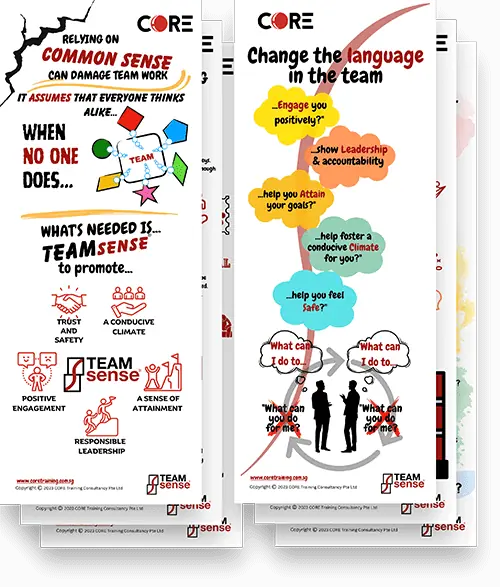There’s no doubt that progressive leadership styles account for job satisfaction in organisations. Leaders who embrace modern leadership styles are more likely to have a new generation of staff thriving under them. Which management styles are we talking about and what are the key characteristics of these different methods and behaviours that make or break an organisation’s level of productivity and efficiency?
Charismatic Leadership Style
A charismatic leader inspires and motivates their staff to perform optimally in the workplace. They encourage interactive engagement while cultivating an optimistic work environment. Charismatic leaders boost high morale among their team members, using a combination of interpersonal skills, persuasiveness and charisma.
Charismatic leadership styles focus on building and creating interactive relationships with the employees. Staff loyalty and commitment to the leader is done by tapping into their emotions and building a sense of trust while being known for their charming personality!
The key characteristics of a charismatic leader include:
- Clear and precise communication skills: The leader speaks openly while sharing their exact thoughts without saying too little or too much. This is done professionally at all times. They’re active listeners.
- Confidence: Self-confidence, proper posture and body language are typical of this type of leader.
- Empathy: Having high emotional intelligence, these leaders are compassionate towards their employees.
- Maturity: Charismatic leaders can push their staff in the right direction based on their own levels of expertise and experience in the business world.
Other key characteristics include humility, self-awareness and passion for everything the leader does.
Situational Leadership Style
Flexibility and the ability to change methods and behaviour to match the situation or team components are essential elements of this leadership style. A situational leader can assess the team members and adapt their style to align with the staff’s level of development and readiness for a task. They consider each individual’s personality, learning style, motivators and background.
This type of leader can match the individual’s needs while empowering them to bring out their best talents in the workplace. Situational leaders can direct a team that needs close supervision while being persuasive with individuals who shy away from a particular task. They encourage less confident employees to participate while delegating tasks to teams that demonstrate self-motivation.
The key characteristics of situational leadership style include:
- Flexibility: The ability to match the unique and evolving needs of the organisation, project or individuals.
- Active listener: Can listen AND hear when someone speaks while understanding what they’re trying to put across.
- Clear directional focus: The leader directs the team with proper guidance while achieving successful outcomes.
- Motivator: Can create a safe environment for individuals to share their thoughts, ideas and experiences while motivating them to participate actively in meetings and brainstorming sessions.
Situational leadership styles take advantage of coaching skills to empower staff to grow themselves in the workplace while understanding what’s holding them back from progression.

Participative Leadership Style
This style encourages leaders to actively listen to their staff and include them in the decision-making process. The participative leader encourages team members to take responsibility and be collaborative. The leader empowers the team to work together as a collective force and brainstorm solutions without making one individual accountable for solving problems.
This leadership style works well in work environments that encourage employees to be present in the workplace. It’s not as effective for remote or virtual working environments unless the team members can be physically present when collaboration is essential. This type of leader needs to build a trustworthy rapport with their team to successfully achieve project outcomes.
The important features of this leadership style include:
- Transparent and open communication skills: The leader encourages feedback without any judgment.
- Curiosity and spontaneity: This type of leader embraces innovative ideas and is open to hearing different perspectives from other team members.
- Empowerment: Staff are empowered to take the lead with the leader mentoring them to become leaders themselves.
- Open mindset: Can take advice and suggestions from team members while being open-minded about various inputs, acknowledging that there are different ways to approach problems.
The participative management style is also known as democratic leadership.
Transformational Leadership Style
A transformational leader emphasises change and transformation while encouraging staff to become a better version of themselves in the workplace. The transformational leader identifies the unique potential of each individual in the team and helps them to tap into their talents.
Transformational leadership style is all about inspiring team members to embrace personal growth so they can transform themselves into powerful and valuable individuals. This is a particularly useful leadership style for organisations undergoing massive change and transformation. The leader can build essential relationships for growing the company to reach new heights.
A successful transformational leader displays the following characteristics:
- Interpersonal skills: The ability to focus on employees’ strengths while helping them build their abilities so they’re using their full potential. Interacting with others comes naturally to this type of leader.
- Proactive: The leader focuses on the future to meet the organisation’s goals and encourages the team to do the same.
- Courage and resilience: Transformation requires change and it takes a courageous and optimistic leader to manage it. They handle disappointments and failure without giving up on the ultimate outcome.
Transformational leaders have excellent visionary skills.

Coaching Leadership Style
Coaching leadership requires the leader to acknowledge and nurture a person’s strengths while developing effective strategies that allow the team to work collaboratively. While similar to the democratic leadership style, it differs in that the leader focuses more on the individual.
A coaching leader encourages individuals to take on new and challenging tasks as a way of developing their potential. The leader will provide guidance and constructive one-on-one feedback while encouraging team members to learn new skills from each other. The key focus is on cultivating strong relationships through trust and psychological safety.
The following characteristics are essential if a leader wants to succeed with this approach:
- Personal development skills: The leader strives to develop individuals within the team.
- Clear communication skills: There must be no ambiguity when conversing with the team ensuring every member is fully aware of their role in achieving the outcome.
- High emotional intelligence: Empathy, compassion and understanding of what makes a person tick is a vital skill for empowering personal growth in the workplace.
- Open-minded: The leader can appreciate feedback while giving constructive criticism at the same time.
A successful coaching leader is self-aware and accessible.
The above five leadership styles are transforming the way leaders work with a new generation of staff. These methods and behaviours encourage better workplace productivity and job satisfaction, both key for retaining valuable talents within the organisation.
Servant Leadership Style
Servant leadership means the leader focuses on the greater good while using a variety of methods to get the most out of a team. With the right approach and key characteristics, a servant leader can build trust, boost motivation and get positive results. This type of leader wants to make an impact that’s far-reaching and serves everyone involved.
Servant leaders avoid prioritising themselves but rather pay attention to offering support to others while serving the organisation wholeheartedly. They bring their own expertise to the table while empowering growth within the team. The servant leader conveys their strategic vision for the company and lets employees take ownership of the projects.
Successful servant leadership entails the following characteristics:
- Job satisfaction: The employees’ fulfillment in the workplace comes first.
- Teamwork: Collaboration and cooperation are encouraged.
- Flexibility: Adaptability within entities that focus on the greater good of society.
- Open communication: Transparency and clarity reassure the team that they’re in good hands.
- Optimism: The leader can motivate staff to do their best.
- Authentic: Genuine servant leadership includes a leader who wants to see their team reach their full potential.
A servant leader ensures every individual is accountable for their role within the organisation.
Autocratic Leadership Style
The autocratic leader takes full control of decisions and doesn’t encourage input from the team. It’s not a leadership style that’s easily embraced by a new generation of staff. However, in certain situations this management style is essential and the leader needs to know when it’s most applicable for best results.
Knowing when to use this leadership style depends largely the project, the team composition and the level of control required to meet goal expectations. The key element of this leadership style is a leader that has a full command with a definite separation from the rest of the team. The approach is rigid and highly structured.
The key characteristics of autocratic leadership include:
- Zero “out-of-the-box” thinking: Sharing of thoughts and ideas aren’t encouraged.
- Control: The team has no say on how a task is handled with the leader taking full control of the situation.
- No confidence in the team: Staff aren’t trusted to handle significant tasks.
- Limited creativity: Team members aren’t encouraged to be creative or do things differently. Work processes and methods are determined by the leader only.
There are very strict rules regarding how a team communicates with the leader and within themselves.
Laissez-faire Leadership Style
These leaders have a hands-off approach, letting their team make decisions and solve problems on their own. While this sounds like a healthy leadership style, it often results in poor workplace productivity. To make this method successful, laissez-faire must emphasise regular work performance reviews and identify when the situation is best suited for this approach.
The laissez-faire leadership style is most effective when the leader has a team of experts handling the project or goal. The leader should be accessible for team members to discuss concerns or ideas with them and who are looking for constructive feedback. A great deal of trust is required for this style to work efficiently.
A successful laissez-faire leadership style is characterised by the following:
- Trust: The leader has faith in the team’s ability to make the right decisions for the situation.
- Accountability: Takes full responsibility for the outcome of the project.
- Accepts failure: The leader is comfortable with the team making mistakes knowing that they’ll find the right solution eventually.
All training and support of the team is the responsibility of the laissez-faire leader.
Transactional Leadership Style
This leadership style focuses on rewards and punishments. It emphasises structure with clearly stipulated team tasks and goals. Typical rewards are normally financial in the form of bonuses or a 13th cheque. Tokens of appreciation and incentives are other formats of reward-driven goals.
The transactional leadership style relies heavily on rigid procedures and routines rather than bringing about change and transformation. Each staff member is given a specific role and responsibilities with little scope for development and growth within the workplace. Poor work performance can result in some form of punishment such as withholding bonuses.
The key characteristics of a transactional leader are:
- External motivation: Money, praise or recognition is used to drive the team to produce results.
- Pragmatic: A practical and dogmatic approach that factors in constraints and potential obstacles.
- Resists change: This style doesn’t accommodate transformative approaches.
- Conventional: Autonomy isn’t encouraged!
- Performance-driven: This type of leader relies on work performance driven by pre-determined targets and goals.
Employees who thrive under this management style are those who need clear directives and instructions to perform optimally in the working environment.

Bureaucratic Leadership Style
This management style is all about following rules however, the leaders are open to listening
to input from team members. But, if it doesn’t align with the organisation’s policies or practices, they’ll not consider such thoughts or ideas.
The bureaucratic leadership style works best for established or traditional entities that rely on age-old business approaches to succeed. These companies don’t want to change their business models or structures because they continue to produce the best results for the organisation. A bureaucratic leader is hesitant to try new methods in case it wastes resources and valuable time.
The key traits of bureaucratic leadership styles include:
- Hierarchy: There’s a definite structure between roles and departments with a clear chain of command from top to bottom.
- Specialisation: Roles and tasks are only allocated to employees who are experts in specific areas.
- Detachment: There’s a collective focus on the organisation as a whole and how it performs rather than embracing individuality in the workplace.
- Stringent rules and procedures: Very specific guidelines are stipulated for work processes with policies put in place for employee conduct and work performance.
This type of leadership style requires impartiality towards all staff with standard procedures firmly in place.
Paternalistic Leadership Style
A paternalistic leader acts as the matriarch or patriarch of the organisation, treating their employees as one, large family. It’s a dominant leadership style that requires subordinates to be loyal, obedient and trustworthy while showing full commitment to their leader and the company.
This authoritarian approach however does aim to develop and grow the employees, cultivating independence and progression amoung the team. If managed properly, this management style needn’t be a dictatorship but rather allows a safe environment for staff to thrive and work to their full potential.
The key characteristics of the paternalistic leadership style include:
- Decisiveness: This is essential for planning and prioritising tasks as well as for placing staff in the right roles.
- Being organised: A vital soft skill that ensures the outcomes are successfully achieved with proper delegation of tasks for optimal success.
- Compassion: A compassionate leader strives to create a comfortable and healthy working environment for their staff.
- Empowerment: Employees are empowered to do their best by upskilling and encouragement to grow in the workplace.
A skilled paternalistic leader is influential with strong morals.
Delegative Leadership Style
The delegative leadership style allows employees more freedom to take on responsibility and make decisions. Staff work on their own, deciding how and when to do tasks allocated to them while meeting deadlines on time. While the team may have more decision-making powers, the final result rests on the leader’s shoulders.
This management style, if properly implemented, can prevent burnout, allow for effective use of various skill sets and improve overall job satisfaction. A delegative leader refrains from micromanaging while still staying on top of what is happening within the team.
Similar to the laissez-faire management approach, the delegative leadership style characteristics include:
- Hands-off method: Tasks and responsibilities are given to employees with the expectation that they’ll get the job done with minimal interference.
- Confidence: The leader trusts their team to make the right decisions because they are equipped with skills and knowledge to reach goals successfully. The manager also has strong confidence in their own ability to handle projects or organisational management.
- Inspiring: A delegative leader motivates their team by delegating tasks and handing over responsibilities.
This type of leader is positive, often has a sense of humour and should be innovative.
Summing It Up
Every leadership style has its pros and cons and knowing which one is appropriate for certain situations and organisations is a skill that every leader should have. At Core Training Consultancy, our professional team can empower leaders to transform their staff. Give us a call to find out more!
If you found our list of leadership styles informative and useful, feel free to share it with other leaders. This way, you’re informing and empowering others to be better leaders.




